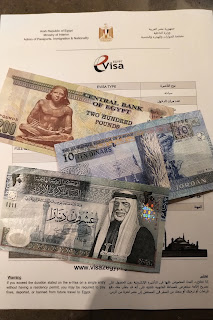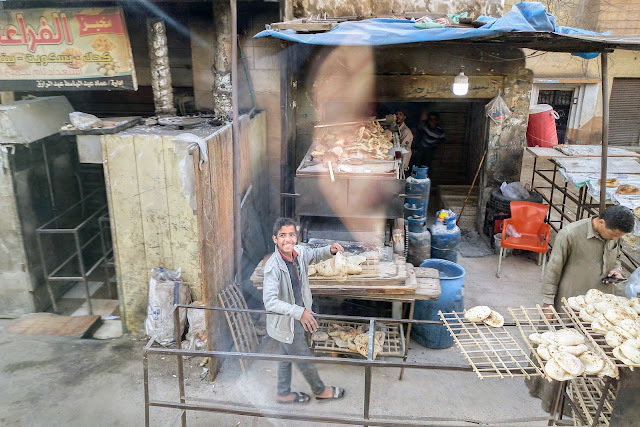Cairo - Day 2
Sunday, Feb. 23
Day 2 in Cairo began with a bus ride through the chaos that is locally known as light traffic to the Citadel built on the central height of land in the city. The construction was done under Salah Ad Din, one of the principal leaders during the Crusades. The massive wall and some of the interior buildings were constructed from the smooth facing stones taken from the pyramids. Why cut new ones when there is a readily available source of materials close by?
The Alabaster Mosque within the walls of the Salah Ad Din Citadel
Within the Citadel walls is the Alabaster Mosque, one of the largest in Cairo. No prayers were going on so, after donning shoe covers, we entered with our guide Akram. Within the mosque central area is the burial place of Muhammad Ali who, although he was not born in the country, is considered as the founder of modern Egypt. He also had a home in the citadel.
Following our visit to this site, we stopped for lunch and then went to the Egyptian Museum, the main antiquities museum in the country. The collection of ancient items and artifacts is massive. A little long-winded at times, Akram spoke about a number of selected exhibits.
Interesting antiquities in the Egyptian Museum
Interesting antiquities in the Egyptian Museum
The gem of the museum is the King Tut collection with a separate room dedicated to the key gold pieces from his tomb in The Valley of The Kings. (No photos in this room) His famous death mask is made from 11kg of gold and precious stones. His gilded inner sarcophagus was also on display along with the more personal and valuable golden items found on or near his body. This included his steel dagger which, scientists believe, is made from the iron contained in a meteorite found by the ancient Egyptians. For this reason, the dagger was looked on as a gift to Tutankhamen from the gods.
Statue of Tutankhamen
Statue of Tutankhamen
Larger stone items in the museum on display are not protected at all. Some painted items and those made of wood are displayed in cases made of wood and cheap glass that looked like they came from the basement of an old university storehouse. Many of the items are dust covered. Rows of sarcophagi line walls in a long hall. To an untrained observer, the minimal protection offered does not do justice to the magnificent antiquities. I know that the ancient Egypt collection at the R.O.M. in Toronto gets much better care. Perhaps the Egyptians have so many antiquities that they have become blasé about their care and protection.
The government of Egypt is in the process of completing a new museum. At that site, which is supposed to be state of the art, all 5000 items found in the tomb of King Tutankhamen will eventually be displayed. Some of these have never been seen by the public. The museum will also house laboratories and workrooms in which restoration and protection of the more fragile items will be handled.
We left the group at the Egyptian Museum to meet up with Nabil for some exploration of lesser seen Cairo sites. We visited the massive necropolis area also known as the city of the dead which houses family mausoleums centuries old. Now, about one million people have taken up residence in many of these structures even though some are still used and visited regularly by the families of the deceased interred there. The local government supports the squatters there and have installed water and electricity service. We supposed that the government feels that this helps to solve the problem of finding places for the homeless citizens to live.
Within the necropolis, we stopped at a historic site, a mausoleum from the 1800s where the wife and family of Muhammad Ali are entombed. Within are arched rooms lit by stained glass windows. The bodies are underground with triple tiered monuments over them decorated with Islamic art and prayers. Some 45 bodies repose there.
Our next stop was the Coptic Christian area of Cairo where we visited a few sites including two churches, stopping at the location of the cave which is reported to be the location where Jesus and his parents lived after they fled Bethlehem following His birth.
Entrance to a Coptic Church
Entrance to a Coptic Church
Nabil also checked up on a friend who lives across the narrow lane separating her tiny 2 room home from the local church. She is a tiny Egyptian senior who he met some time ago and he drops by to say hello and see how she’s doing when he is in Cairo. She was quite happy to see him and meet more Canadians.
Our excellent dinner was at an Egyptian restaurant on the island in the middle of the Nile River. Back at our hotel, we parted ways with Nabil. He is heading back home in a few days, and tomorrow, we are off to Luxor to begin the cruise on the Nile segment of our trip. Lesson learned: if you’re coming to Cairo to visit, bring along your own local Egyptian.
Our group is 66 strong, divided into 3 groups of 22 each. All 8 of the Jordan group are with us in Group 2. The busses we used seat 44 so we have lots of room. We also have a plain clothes armed guard with us. Security is very evident. At the hotel and most sites, even going into the Bazaar, one passes through a bag checks, X-ray, and metal detectors. At the Citadel, grey-suited security officers carry small Uzzi-like automatic weapons that hang from one side below their suit jackets.















Comments
Post a Comment